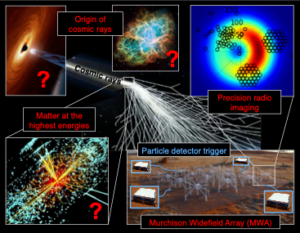Project area/S
- Pulsars and Fast Transients
Project Details
Cosmic rays are the highest-energy particles in nature. They hold clues not just to their origins in some of the most energetic processes in the Universe, but also particle physics at energies higher than can be reached by the Large Hadron Collider.

Schematic of cosmic ray detection at the Murchison Widefield Array: particle detectors trigger when particle cascades caused by cosmic rays interact in the atmosphere above the telescope. The precision radio imaging can then be used to inform on high-energy particle physics and the origin of cosmic rays.
When a cosmic ray impacts the upper atmosphere, it emits a brief, nanosecond-duration pulse of radio waves. We have re-cently constructed an array of particle detectors to detect parti-cle cascades from high-energy cosmic rays, and trigger the Murchison Widefield Array (MWA) to record data. This will allow us to study cosmic ray signals with utmost precision.
This project will involve working with MWA data triggered by our particle detector array, to determine cosmic ray arrival direc-tions, their energies, and in particular, the polarization proper-ties of their signals, in collaboration with institutes in Belgium, Netherlands, and Germany.
Student Attributes
Academic Background
Any STEM – though physics and coding skills will be more relevant than astronomy.
Computing Skills
Python, C++, supercomputing useful, but can be taught
Training Requirement
Familiarisation with basic Pawsey usage.
Project Timeline
| Week 1 | Inductions and project introduction |
| Week 2 | Initial presentation |
| Week 3 | Working with particle detector trigger data; introduction to cosmic ray physics |
| Week 4 | Working with MWA triggered data and polyphase filterbank inversion |
| Week 5 | Pulse reconstruction |
| Week 6 | Fitting for arrival direction |
| Week 7 | Beamshape correction |
| Week 8 | Polarisation analysis |
| Week 9 | Final presentation |
| Week 10 | Final report |
